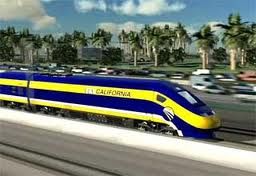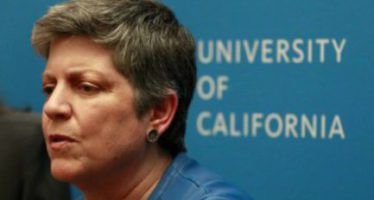High-Speed Rail Rides Again
By KATY GRIMES
Another attempt to stop the unchecked spending on high-speed rail was killed in committee on Monday on a party-line vote. That happened despite research proving that taxpayers cannot sustain the inevitable subsidy the project will require, and claims that voters were misrepresented in the 2008 ballot initiative.
Dana Point Republican Assemblywoman Diane Harkey faced a full committee room and even some heckling as she spoke Monday to the Assembly Committee on Transportation. AB 76 would have reduced the amount of general obligation debt for the High-Speed Rail, starting in January 1, 2012.
In 2008, voters approved $10 billion in bonds for the “High-Speed Passenger Train Bond Act for the 21st Century under Proposition 1A. But to date, very little has been built, and already millions of dollars have been spent. One study reported ($1M means $1 million):
By July this year, the State will have spent about $500Million on studies and public relations. The present CHSRA budget for July 31, 2010 to June 30, 2011 is $231 million, over $1M/working day. That supports about 30 staff and 600 full time equivalent (FTE) consultants. These planners, engineers and managers each cost an average of $355,385 this fiscal year. For that price the project could have given jobs to seven of your colleagues or neighbors.
The rail project was awarded $3.6 billion by the federal government, and the High-Speed Rail Authority applied recently for even more money from the feds. But more federal funding is not a sure thing. According to the AB 76 fact sheet, $9 – $10 billion is only the startup cost for the rail project. The High-Speed Rail Authority estimates the costs in excess of $40 – $60 billion.
However, several rail experts put the actual cost estimates of the rail project somewhere between $60 billion and $116 billion (that’s $60,000,000,000 to $116,000,000,000 — nine zeros).
Unknown Risks
In 2009, the Legislature approved $139 million to fund the preliminary planning of the rail system. But since then, according to a high-speed rail briefing paper done in January:
[B]y the close of 2010, 25 months after Prop 1A, no private investor has come forward with any of the $10-12 billion required for the project’s capital development. Unless the State and/or Federal governments build or guarantee Phase One’s capital construction costs, there will be no project; a fact the Authority knew in mid-2008.
“What are the risks of the project? We don’t even know,” Harkey said, critical of the large, as-yet-unknown debt California will be taking on. “It could be $66 to $100 billion, and that’s without the train sets and without the operating expenses.”
Harkey was also critical of the 120 miles of prime farmland that will be dissected in order to lay tracks for the rail. “Farming is our largest employer in the state,” she said.
And Harkey said that the system is estimated at $677 million per year to operate, once the construction has been completed.
Analysis Needed
Another bill has been introduced by Harkey that would require an “Investment Grade Analysis” by the state auditor of California’s High-Speed Rail Authority to provide a timeline and benchmark of the costs, duration, risks and ridership.
Ridership has been an issue with the project as well. The study reported:
The 2008 proposition reported that more than 100 million riders annually would use the train by its tenth operating year (2030). By 2009, CHSRA was claiming only 39 million riders by 2030 for its LA/Anaheim to San Francisco Phase One. But even that claim doesn’t withstand scrutiny. One notable bias is the claim that 96 percent of the Californians surveyed expressed an interest in taking High-Speed Rail. But contrary to best practices and known to produce bias, the sample was a survey of train-based commuters.
But for all of Harkey’s facts, challenges to the ridership figures, and concern for the lost farmland and agriculture jobs, the chairwoman of the transportation committee, Long Beach Democrat Bonnie Lowenthal, told Harkey that she would vote against the bill. “I think you and I are going to disagree about the merits of high-speed rail because I believe there is a possible success story out there,” Lowenthal said. “So for that reason I am going to oppose your bill.”
As expected, pushback came from the High-Speed Rail Authority. “Put really simply, this bill would kill high-speed rail in California. We believe that’s against the will of the people who voted for the project,” said Jeff Barker, deputy executive director of the High-Speed Rail Authority.
Support for Harkey’s bill came from agricultural and farming groups in the state, the Howard Jarvis Taxpayers Association and even from some supporters of high-speed rail. Rich Tolmach, one of the state’s leading rail experts, said he is a big supporter of high-speed rail, “But sanity and accurate data need to be applied to the bill.”
Opposition came from numerous college students, the Building and Trades Council, the California Labor Federation, the Operating Engineers, teamsters, machinists and other labor groups.
The 14-member committee voted the bill down along party lines. “You’ll be hearing from me again,” Harkey said after the vote.
Related Articles
Bridge Tax Fails; Local Tax Passes
JUNE 13, 2011 By KATY GRIMES In the California Senate Friday, after a week of budget talks and hearings, the
Legislative bipartisan criticism aims at Covered CA spending
Responding to a state senator’s call for an investigation into the marketing budget of California’s Obamacare exchange, the agency
Janet Napolitano rebukes policing speech on college campuses
With a single op-ed, UC chief Janet Napolitano has become an unlikely ally of conservative and traditionalist critics of the





